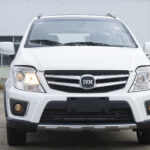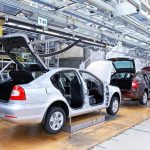The increasing price of petrol in Nigeria, the largest economy in Africa, is prompting some Nigerians to opt for vehicles with smaller engines and higher fuel efficiency in order to save money. As the subsidy on petrol was removed, resulting in a new price range of N488 to N577 per litre, Nigerians are adapting to the change. This adjustment is evident as the queues at petrol stations gradually disappear, indicating that people are finding ways to cope with the higher fuel costs.
Table of Contents
One strategy is to choose cars with smaller engines that consume less fuel. These vehicles are known for their higher fuel efficiency, allowing motorists to travel more miles per litre of petrol. By selecting such cars, Nigerians hope to offset the increased fuel prices by reducing their overall fuel consumption.
This shift in consumer behaviour reflects the economic impact of the subsidy removal and the need to find cost-effective alternatives in the face of rising petrol prices. Nigerians are making practical adjustments to their transportation choices in order to navigate the new era of higher fuel costs.
If you must drive, here are 10 ways to reduce fuel consumption
Even though we are aware that engines need fuel to run, that does not mean you can’t make some small changes to help you gain some fuel savings.
- Keep tires pumped up
Tires that are underinflated have a higher rolling resistance on the road. This means that with every kilometre travelled, your tires generate more friction and rolling resistance, and hence, will increase fuel consumption. If all your tires are underinflated by 10 psi, this could reduce fuel efficiency by up to 10%. - Lose the weight in your boot
For those with a habit of keeping everything and anything in the boot, in addition to emergency spares, think twice when loading up next time. Every extra 50kg your car puts on increases fuel consumption by 2%. - Drive with AC
Driving with the windows down at speeds faster than 80km/h causes a lot of wind resistance, and costs you a lot more fuel. Contrary to what you may think, in this situation, it’s simply more fuel efficient to drive with the aircon on. - Don’t go too fast or too slow
When cruising down a highway, your engine works hard to overcome wind resistance. You’ll burn up to 15% more fuel at 100 km/h and 25% more at 110 km/h. That might tempt you to drive slowly, but if you drive slower than 50 km/h, your engine would drop to a lower gear, thus using up more fuel. In conclusion, a steady 50 – 90 km/h on the highway is best to achieve optimal fuel economy. - Remain steady when accelerating
Avoid revving your accelerator to a high revolution per minute (RPM). It’s better for fuel economy, as your engine uses less fuel when it is revolving slower, at a lower RPM. - Avoid braking aggressively
Slamming on the brakes increases fuel consumption as you need to accelerate again later. This is especially true if you follow too closely behind the vehicle in front of you. Not to mention, tailgating is dangerous and something to avoid. - Cruise in top gear
If you’re driving an automatic car, make use of cruise control to keep your speed constant. And if you’re driving a manual car, maintain a higher gear when appropriate. In each of these instances, your engines go through fewer revolutions per minute (RPM) and will reduce your fuel consumption. - Practice predictive driving
Look to the road ahead and plan your next move. Instead of slamming on the brakes to a complete stop, try slowing down as you approach the red light. Or when reaching the foot of a hill, start accelerating as you edge closer to it rather than when you approach it. Avoid hard accelerations when moving your car from a complete stop, or climbing a hill as it will increase fuel consumption. - Plan your rush hour route
Stop-start traffic puts a lot of pressure on your engine, thus burning more fuel. When possible, plan your commute to and from work carefully to help you avoid the worst of peak traffic. - Don’t stay idle for long
If you are waiting for something or someone for more than three minutes, turn off your engine. You may not be moving but as long as your engine is on, it’s burning precious fuel.
According to a 2022 report by the National Bureau of Statistics, Nigerians spend an average of 10 per cent of their disposable income on petrol. This is significantly higher than the global average of 4 per cent.
Top available fuel-efficient cars include Toyota Prius, Honda Civic, Kia Niro, Toyota Corolla, Hyundai Ioniq, Toyota Yaris, Kia Rio, Nissan Versa, Honda Insight and Volkswagen Polo, but how affordable are these cars, don’t panic, let’s dive into the top FIVE cheap Fuel-Efficient Cars In Nigeria Market Right Now
Toyota Corolla

The Toyota Corolla is one of the most popular cars in Nigeria. Almost everyone in Nigeria drives a Corolla, and if you are looking for something that is not only fine looking but can conserve fuel very well, then this car is surely your plug. Its fuel economy power ranges between 10 km/L to 13.7 km/L and it’s one of the cheapest sedans u can buy in Nigeria.
You can buy Toyota Corolla for 1.5 million naira for a Nigeria used, for more cleaner tokunbo used you should be expecting to get it from 3 million naira upwards.
- Find a used Toyota Corolla
Toyota Prius

The Toyota Prius gained a new 2.0-litre engine and lithium-ion battery in its 2023 redesign, and the updates boosted the hybrid’s power output and fuel efficiency. The Prius’ base 194-hp LE trim with FWD is the most efficient at 57/56/57 mpg; opting for the 196-hp AWD variant with a second electric motor drops fuel economy to 53/54/54 mpg. Stepping up to higher trims like the XLE and Limited also means a lower rating of 52/52/52 mpg with FWD and 49/50/49 mpg with AWD.
Find a used Toyota Prius
Toyota Camry

Just like the Toyota Corolla, the Toyota Camry is also popular on Nigerian roads. It is affordable, nice exterior, is easy to handle and drive, is comfortable, and easy to maintain, and getting its car maintenance part isn’t stressful as it is a popular car in Nigeria. Its fuel efficiency capacity ranges between 9.8 km/L to 13.6 km/L.
Find a used Toyota Camry
Hyundai Sonata
Comfort, affordability, and ease to use are the highlights of this car. It offers a fuel efficiency range of 8.5 km/L to 13.9 km/L. It is also popular on Nigerian roads, as it is beautiful to look at and comes at a very affordable price.
Find a used Hyundai Sonata
Kia Optima

Kia Optima is another popular car on Nigerian roads best known for its affordability, ease of use, and fuel economy. The Kia Optima, a midsize sedan, has been known for its good fuel efficiency. However, please note that the fuel efficiency of a vehicle can vary depending on various factors, including the engine type, driving conditions, and driving habits. The fuel efficiency figures provided below are based on general estimates for the Kia Optima, but it’s always recommended to refer to the specific model and engine specifications for more accurate information.
- Find a used Kia Optima
Top Fuel efficiency has improved since 1975
Since 1975, the average CO2 emission for new cars has dropped from close to 700 CO2 grams/mile (g/mi) to 347 g/mil, the lowest on record. The fuel economy has also hit record numbers, in a good way. In 1975, the average car got 13 miles per gallon (MPG). We have come a long way since then, with the average car in model year 2021 hitting a record high of 25.4 MPG.
Since 1975, here are the cars with the best fuel efficiency, including hybrid and electric vehicles:
| YEAR | MAKE & MODEL | REAL WORLD FUEL ECONOMY (MPG) | ENGINE TYPE |
|---|---|---|---|
| 1975 | Honda Civic | 28.3 | Gas |
| 1980 | VW Rabbit | 40.3 | Diesel |
| 1985 | GM Sprint | 49.6 | Gas |
| 1990 | GM Metro | 53.4 | Gas |
| 1995 | Honda Civic | 47.3 | Gas |
| 2000 | Honda Insight | 57.4 | Hybrid |
| 2005 | Honda Insight | 53.3 | Hybrid |
| 2006 | Honda Insight | 53.0 | Hybrid |
| 2007 | Toyota Prius | 46.2 | Hybrid |
| 2008 | Toyota Prius | 46.2 | Hybrid |
| 2009 | Toyota Prius | 46.2 | Hybrid |
| 2010 | Honda FCX | 60.2 | FCV (Fuel Cell Vehicle) |
| 2011 | BMW Active E | 100.6 | EV |
| 2012 | Nissan-i-MiEV | 109.0 | EV |
| 2013 | Toyota IQ | 117.0 | EV |
| 2014 | BMW i3 | 121.3 | EV |
| 2015 | BMW i3 | 121.3 | EV |
| 2016 | BMW i3 | 121.3 | EV |
| 2017 | Hyundai Ioniq | 132.6 | EV |
| 2018 | Hyundai Ioniq | 132.6 | EV |
| 2019 | Hyundai Ioniq | 132.6 | EV |
| 2020 | Tesla Model 3 | 138.6 | EV |
| 2021 | Tesla Model 3 | 139.1 | EV |
Source: epa.gov
Since 2000, the most fuel-efficient cars have been hybrids, fuel cell vehicles, or electric vehicles. Before then, car manufacturers were able to increase fuel efficiency by making the cars smaller and lighter. However, this also impacted the car’s horsepower. With the introduction of hybrids and electric cars, manufacturers have been able to increase fuel efficiency without sacrificing power.
Have 1 million naira and above to Buy or Sell Cars In Nigeria? Check carlots.ng
All rights reserved. Reproduction, publication, broadcasting, rewriting, or redistribution of this material and other digital content on carmart.ng is strictly prohibited without prior express written permission from Carmart Nigeria - Contact: [email protected]








